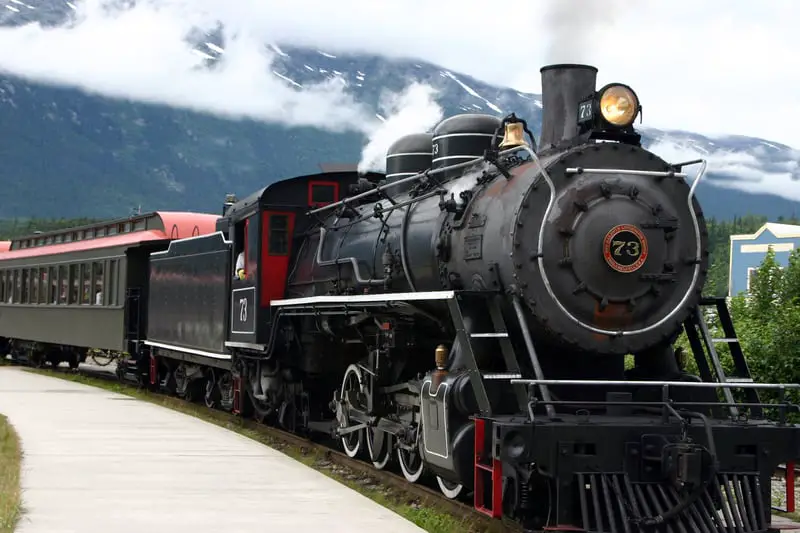
Names such as the Trans-Siberian, Orient Express, Flying Scotsman, Blue Train, Eurostar, Ghan, and the Rock Island Rockets conjure images of adventurous train journeys to distant destinations.
Most trains run on steel wheels which give trains their characteristic “cluck-cluck” sound for which they’re so famous. Some trains, however, don’t have wheels at all!
Train locomotives are fitted with either eight or twelve wheels attached to a bogie in two or three pairs, called wheel sets. Train carriages which attach to the locomotive, generally have two bogies fitted with two-wheel sets each, meaning they have eight wheels.
Let’s go through the different types of trains and how many wheels they have.
Wheels On a Train
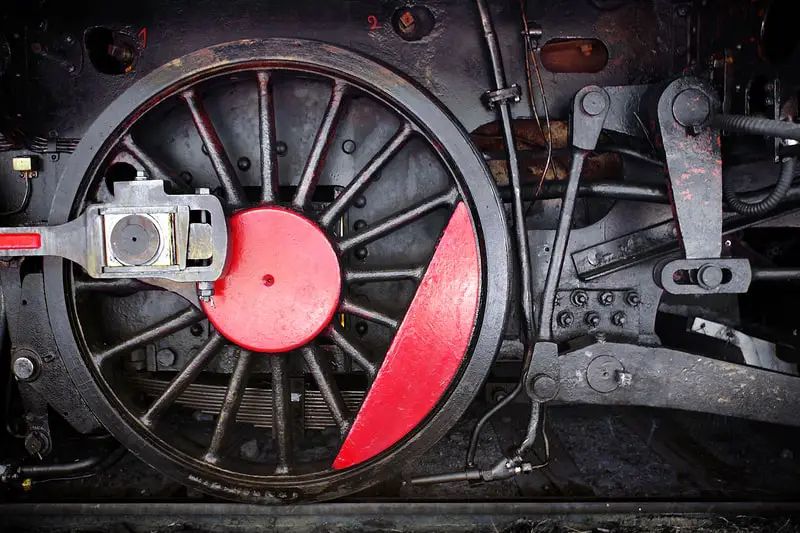
- Passenger Trains: 8 Wheels
- Train Locomotives: 12 Wheels
- Railroad Trains: 12 Wheels
Trains consist of one or more locomotive and railroad cars or carriages numbering into the hundreds depending on their application. The trains that the average person would know are most likely subway trains, passenger trains, and cargo trains.
Passenger trains are fitted with eight wheels, four for the front of the car and four at the rear. The wheels are attached to a pivoting bogie (also called a Truck in North America) that houses two axles with a wheel on either end.
Train locomotives have twelve wheels divided between two bogies housing six wheels each. The locomotive accommodates the driving wheels that propel the train forward or backward.
The power that drives the six wheels of each bogie is provided by DC electric motors or diesel engines, strong enough to drive a fully loaded train that can weigh a couple hundred thousand pounds.
Railroad trains carrying hefty loads are fitted with three sets of four-wheel bogies comprising twelve wheels. The bogies support the railroad car’s front, middle, and rear. Alternatively, the manufacturer may choose two sets of three-wheel-set bogies totaling twelve wheels.
Almost all trains are fitted with steel wheels. Although some subway locomotives, such as those used in the French underground since 1956. These trains use a combination of rubber wheels as the drive wheels and metal railroad wheels located on the inside of the rubber ones to keep the train on the tracks.
The French subway trains also use the double-axel bogie system but have four wheels per axle, meaning the trains have sixteen wheels per locomotive if you include the metal and rubber wheel combination.
Trains With No Wheels
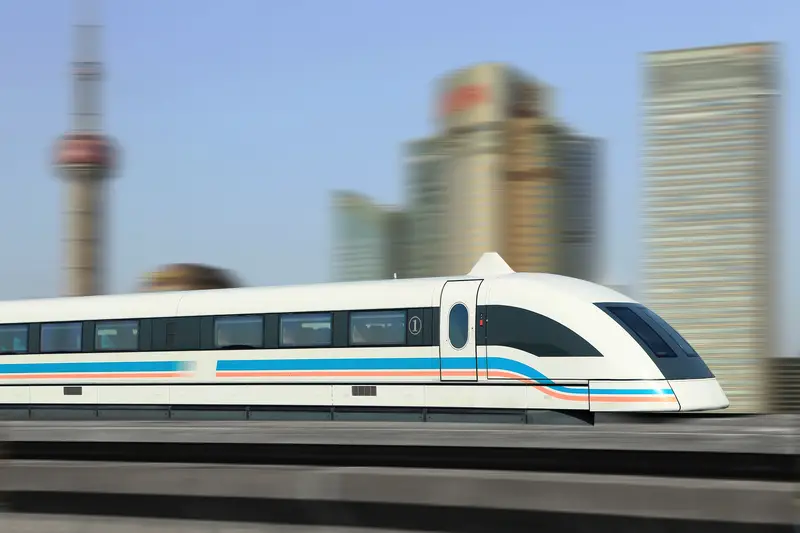
Maglev or magnetic levitation trains don’t make use of wheels at all. Maglev trains are very specialized, requiring purpose-built infrastructure to accommodate the trains. Only six maglev trains currently operate in China (3), South Korea (2), and Japan (1).
The train glides along suspended over a series of magnets located under the train carriage and on the track.
The magnetic forces generated between the magnets are strong enough to levitate the entire train creating an extremely comfortable ride.
Given that the train floats on magnetic forces, the trains can reach speeds of up to three hundred and ten miles per hour (500km/h).
How Many Wheels Do Bullet Trains Have?
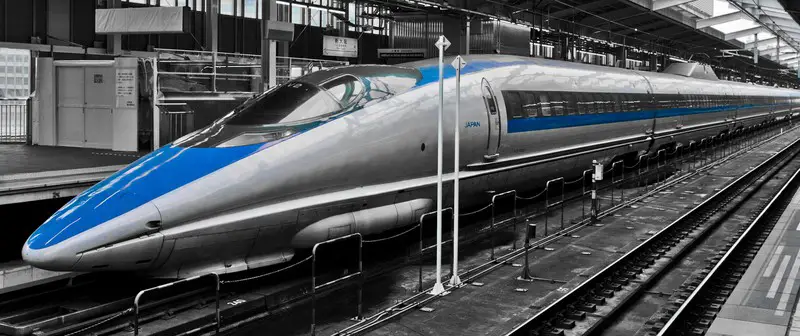
- 8 Wheels
Bullet trains are used primarily for the transportation of passengers. They’ve been given the name due to the high speeds that they travel, often exceeding one hundred and fifty-five miles an hour (250km/h). Sixteen nations currently use bullet trains, with China being the most prominent user.
Bullet trains run on standard-width tracks that have been upgraded to handle the stresses caused by the fast-moving trains. As such, bullet trains do run on hardened high-carbon steel wheels.
The locomotive and rail carriages are fitted with two sets of bogies containing two-wheel sets per bogie. In total, each has eight wheels. The total number of wheels thus depends on the total number of units connected to form the train.
Why Do Trains Have Steel Wheels?
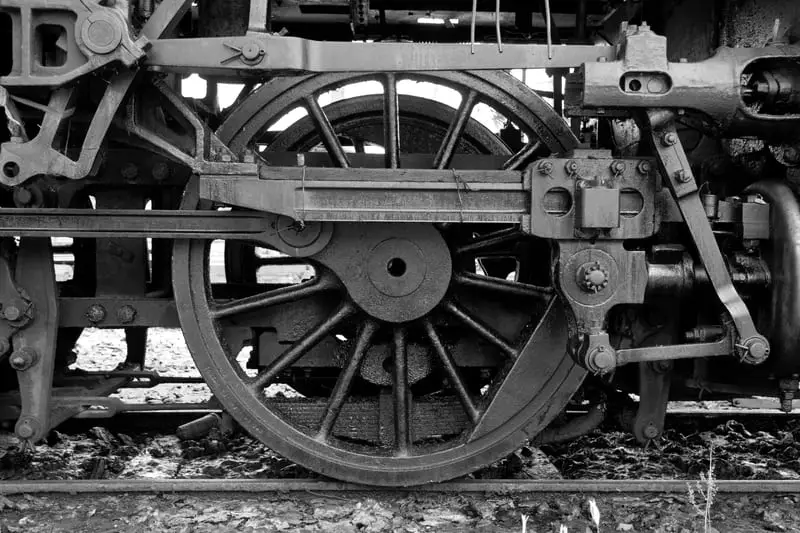
Train wheels are made of steel due to several reasons, of which the following are the most important.
Durability
Steel train wheels are manufactured from hardened high-carbon steel, which makes them highly durable. Trains carry extremely heavy freight, which is only possible because they have steel wheels.
A train’s wheel can last up to seven hundred thousand miles (1.13 million km) before needing replacement. Compare this to a rubber tire of a car that lasts maybe fifty thousand miles (80 000 km).
Low friction
The most significant reason trains use steel wheels, not rubber, is that steel wheels create very little friction. Steel wheels running on smooth tracks significantly reduce the power required to move the train.
Trains require about eighty percent less friction or grip generated by the wheels to run safely on a surface than cars. The train wheels develop sufficient resistance due to the trains being much heavier than the average car.
Trains don’t need to accelerate or brake as fast as vehicles, so the friction generated between the wheel and track is perfectly adequate for the task.
Can Be Reconditioned
A significant advantage of using steel wheels is that they can be refurbished when they develop a flat spot from hard braking or when the wheel loses traction.
Reconditioning the wheel reduces the cost of operating the train as you don’t need to buy a new wheel and reduces downtime when wheel maintenance is required.
Specialized machinery is used to re-profile the wheel by grinding the surface to the desired shape if it’s been damaged. Of course, one can only do this skimming a few times before the wheel becomes too small and needs replacing.
Make Rail Passage Possible
Train wheels are specially shaped or profiled to keep the train securely sitting on the railroad tracks to prevent the train from derailing.
The wheel’s shape keeps the train centered between the tracks, even around tight bends.
Conclusion
Trains vary considerably in design, including the number of wheels a train has. Locomotives, which house the driving wheels, generally have eight to twelve wheels depending on the intended use, which governs the bogie or truck design.
Rail cars generally have eight wheels per car attached as two wheel sets per bogie. Heavy freight rail cars are often fitted with three bogies, meaning they have twelve wheels.
